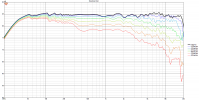I went through the list and suddenly realised that you are specifying our Silver 5L & BH bass augmentor system.Requirements for Directiva r2
As the main Directiva r2 stakeholder and project lead, questions or comments should be directed to me.
- The r2 speaker should be active and simple to build. It will utilize a bass module and a upper monitor module. Use of commercially available cabinets (notably for the monitor) is preferred if possible.
- The design should be reusable and extensible to allow for design variants. Minidsp 2x4 HD will be used as the active crossover for design and costing purposes. Seas DXT tweeter is to be re-used from r1 unless design team finds a less expensive substitute(s) with better performance.
- Bass extension is targeted to be comparable to r1, but the bass module should provide additional bass output to allow for use in rooms up to 150 cubic meters. Listening distance is targeted to be 3-5 meters. The monitor module itself can have less bass extension than r1 to allow for use with existing subwoofers or other bass modules.
- The bass module should be designed for accurate bass reproduction and low distortion. A sealed cabinet design is preferred.
- The design may include passive crossover circuitry to help reduce the number of active channels and allow for a passive version of the monitor section.
- Directivity should exceed r1. The primary requirement is for more consistent directivity over a more extended frequency range. Extensibility of bass module design may consider use of variable directivity, but this is NOT a primary requirement for r2. For the monitor, custom waveguides should be avoided.
- The cost target for the drivers and crossover would be approximately $1600 US retail per pair. This cost includes the cabinets, and active crossover but NOT the amplification.
- The combined cabinet volumes should be 60-75 liters or smaller. Combined height should not exceed 1.2m
- The monitor module should be no wider than 50 mm more than the midwoofer used and the bass module should be wide enough to allow monitor to be securely fitted on top. The target width of the bass module is a maximum of 260 mm.
- The electronics should be external, but the modules may consider added volume (above stated target) for those who prefer internal active electronics.
- The design tools should be free but flexible enough to allow external data import/export. Plan to continue with VituixCAD and REW.
- The design should be openly shared and FOR NON-COMMERCIAL USE ONLY.
The deadline for comments is October 31 and plan to finalize the requirements by November 1.
Thanks!
Rick
However, I assumed that since 90s, speaker design can be a bit more risky. (Joke.
Your list is very good.)




